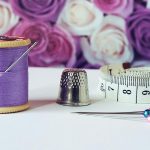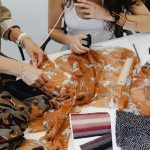When you're pinning layers of fabric, the process can significantly affect your final outcome, so it's crucial to get it right. Start by preparing your fabric properly and choosing the right pins for the job. You'll find that aligning edges and using effective techniques can make a world of difference, especially with tricky materials. But what's the best way to ensure precision while keeping your workflow smooth? Understanding the nuances of pin placement and organization may just hold the key to elevating your sewing projects to the next level.
Table of Contents
Key Takeaways
- Choose the right pins based on fabric type, using fine pins for lightweight fabrics and thicker pins for heavy materials.
- Pre-wash, dry, and press fabric to ensure smooth, clean layers for accurate pinning.
- Align edges carefully and insert pins perpendicular to fabric edges for stability and easy removal.
- Space pins 4 to 6 inches apart, adjusting for slippery fabrics or curves by using more pins.
Choosing the Right Pins
When it comes to pinning fabric, selecting the right pins can make all the difference in your sewing project.
You'll want to consider the type of fabric you're working with, as different materials require different pin styles. For lightweight fabrics, opt for fine, sharp pins that won't leave noticeable holes. For heavier fabrics, like denim or canvas, choose thicker, sturdier pins that can handle the extra bulk without bending.
Another factor to consider is the length of the pins. Longer pins can secure multiple layers of fabric easily, while shorter pins are often easier to maneuver in tight spaces. You might also want to try glass-headed or colored pins, as they're easier to see and can withstand heat from an iron.
Don't forget about specialty pins! If you're working with knit fabrics, consider using ballpoint pins, which won't damage the fibers. For quilting, invest in quilting pins with a longer length and thicker gauge.
Preparing Your Fabric Layers
To achieve the best results, you should always pre-wash and press your fabric layers before pinning them together. This step helps remove any dirt, oils, or chemicals from the fabric, ensuring a smoother sewing experience. When you press your fabric, it eliminates wrinkles and allows the layers to lay flat, which is crucial for accurate pinning.
Here's a simple overview of the preparation steps:
| Step | Action | Purpose |
|---|---|---|
| Pre-wash fabric | Wash in cold water | Remove dirt and chemicals |
| Dry fabric | Air dry or tumble dry on low | Prevent shrinkage |
| Press fabric | Use a hot iron | Eliminate wrinkles and creases |
After washing and drying, give your fabric a good press. Make sure to pay attention to the seams and edges, as they tend to get wrinkled. Once your fabric layers are clean and pressed, you're set to move on to pinning them together. This preparation not only enhances the final outcome but also makes the pinning process more efficient and precise.
Pinning Techniques for Precision
Pinning your fabric layers with precision is essential for achieving clean, accurate seams in your sewing projects.
Start by aligning your fabric edges carefully. Use your fingers to smooth out any wrinkles or bubbles before you begin pinning. This attention to detail will set the foundation for a successful project.
When you pin, insert the pins perpendicular to the fabric edge. This makes it easier to remove the pins as you sew and prevents any potential shifting. Place pins approximately 4 to 6 inches apart to maintain stability, but don't be afraid to use more pins if your fabric is slippery or if you're working with curves.
For curved seams, try using a technique called “curved pinning.” Insert the pins at a slight angle, following the curve of the fabric. This helps maintain the shape and prevents excess fabric from bunching.
Organizing Pins for Efficiency
Efficiently organizing your pins can save you time and frustration during your sewing projects. Start by choosing a dedicated container, like a magnetic pin holder or a small jar. These options prevent pins from rolling away and help you keep everything in one place.
Next, consider sorting your pins by type and size. For instance, keep your quilting pins separate from your dressmaking pins. This way, you'll grab the right pins without digging through a jumbled mess. You might even want to use small labels or color-coded containers for easy identification.
When you're ready to sew, keep your organized pin holder within arm's reach. This allows you to grab pins quickly without interrupting your workflow. If you frequently switch between different types of pins, a small caddy with labeled sections can be a real time-saver.
Lastly, make it a habit to return pins to their designated spots after each project. This keeps your workspace tidy and ensures you won't waste time searching for pins later on.
With these simple steps, you'll streamline your pin organization, making your sewing experience much more enjoyable and efficient.
Removing Pins Safely While Sewing
With your pins organized and within reach, it's important to know how to remove them safely while sewing to avoid any accidents.
First, always keep your eyes on the needle as you sew. This helps you stay aware of where your hands and pins are. As you approach a pin, use your opposite hand to gently pull it out. Try not to pull the fabric too much, as this can cause misalignment.
It's best to remove pins just before the needle reaches them. This way, you minimize the risk of sewing over a pin, which can break your needle or damage your fabric. If you're using a sewing machine, consider using a pin cushion or magnet nearby for quick storage of removed pins, keeping your workspace organized.
Additionally, if you're sewing thicker fabric layers, be cautious; pins can get buried in the material. Always feel for them before making quick movements.
Lastly, practice makes perfect. With time, you'll develop a rhythm that helps you remove pins efficiently and safely while keeping your sewing project on track. So, stay focused and keep your workspace tidy!
Frequently Asked Questions
What Type of Fabric Requires Special Pinning Techniques?
When you're working with delicate fabrics like silk or chiffon, you'll need special pinning techniques. These materials can shift easily, so using fine pins or clips helps prevent damage and ensures accurate alignment during sewing.
Can I Reuse Pins, and How Should I Care for Them?
Yes, you can reuse pins! Just make sure to keep them clean and free from rust. Store them in a dry place, and check for any bending or damage before using them again to ensure safety.
How Do I Prevent Fabric From Shifting While Pinning?
To prevent fabric from shifting while pinning, you should start by aligning the edges neatly. Then, pin at regular intervals, using plenty of pins to secure layers tightly, ensuring stability as you work.
Are There Alternatives to Traditional Pins for Pinning Fabric Layers?
Yes, there are alternatives to traditional pins for fabric layers. You can use fabric clips, basting spray, or adhesive tape to secure your fabric. These options often provide easier handling and reduce the risk of fabric shifting.
How Do I Store Pins to Prevent Rusting or Damage?
To store pins and prevent rusting, keep them in a dry place. Use a magnetic pin holder or a small container with silica gel packets. This'll keep your pins safe and in good condition for future use.
- How Does Ring Spun Cotton Affect Garment Fit and Shape Retention? - August 13, 2024
- What Are the Challenges in Producing Ring Spun Cotton? - August 13, 2024
- Is Ring Spun Cotton Suitable for Plus-Size Clothing? - August 13, 2024







